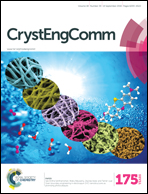Effect of noncovalent interactions on Ag(i)/Cu(ii) supramolecular architecture for dual-functional luminescence and semiconductive properties†
Abstract
Four novel luminescent materials, namely, [Ag3(3,2′,3′-dpob)(bpy)]n (1·Ag), [Ag(3,3′,4′-H2dpob)(bpy)]n (2·Ag), [Ag3(3,2′,3′-Hdpob)(3,2′,3′-H2dpob)(bib)3·2H2O]n (3·Ag), and [Cu(3,2′,3′-Hdpob)(bib)·2H2O]n (4·Cu) [3,2′,3′-H3dpob = 3-(2′,3′-dicarboxylphenoxy)benzonic acid; 3,3′,4′-H3dpob = 3-(3′,4′-dicarboxylphenoxy)benzonic acid; bpy = 4,4′-bipyridine; bib = 1,4-bis(1-imidazoly)benzene] have been hydrothermally synthesized by mixed ligands and characterized using single crystal X-ray diffraction, infrared (IR), elemental analysis and thermogravimetric analysis (TGA). The crystal structures of four compounds indicate that the hydrogen bonding (O–H⋯O, C–H⋯O and C–H⋯π) and π⋯π stacking interactions play critical roles in the formation of the extended supramolecular array. 1·Ag displays a rare 3D compact structure with a 1D right-handed helical chain [–Ag1–CO2–Ag3–CO2–Ag1–]. 2·Ag and 3·Ag exhibit a 3D supramolecular architecture linked by intermolecular hydrogen bonds based on a 1D double-chain and 1D triple-chain, respectively. 4·Cu shows a 1D + 1D → 2D sheet, which is propagated to form an extended 3D structure with pcu (primitive cubic) topology via π⋯π stacking. The four compounds display remarkable narrow band emission with smaller full width at half-maximum (FWHM) (77 K, 97.91, 92.27, 72.98 and 77.96 nm; 298 K, 169.41, 241.98, 293.66 and 148.50 nm) in the solid state. The combination of such narrow FWHM and the red-shift from 298 K to 77 K endow them with a prominent thermochromic effect. It is worth noting that 2·Ag and 3·Ag display good aggregation-induced emission (AIE) properties. Both of them show very weak luminescence in dimethyl sulfoxide (DMSO, good solvent) while their intensities increased enormously with the addition of water (H2O, poor solvent) due to aggregation. In addition, adsorption spectra reveal their semiconductive nature (2.35 eV for 1·Ag and 2.91 eV for 3·Ag) and the role of Ag⋯Ag interactions in controlling the performance of semiconductive properties is highlighted.


 Please wait while we load your content...
Please wait while we load your content...